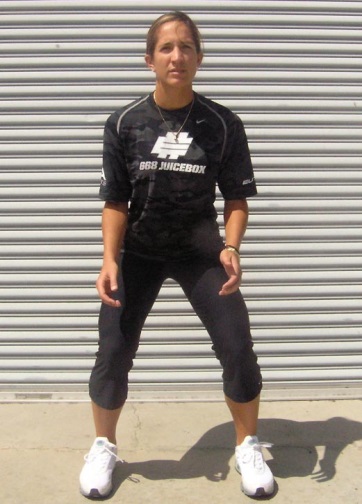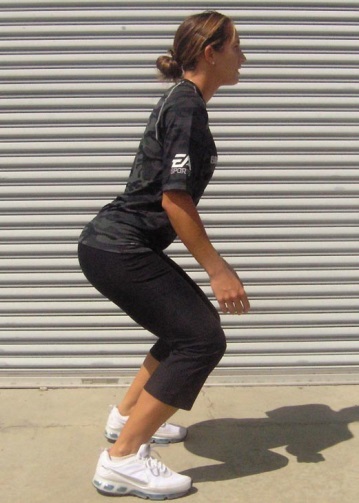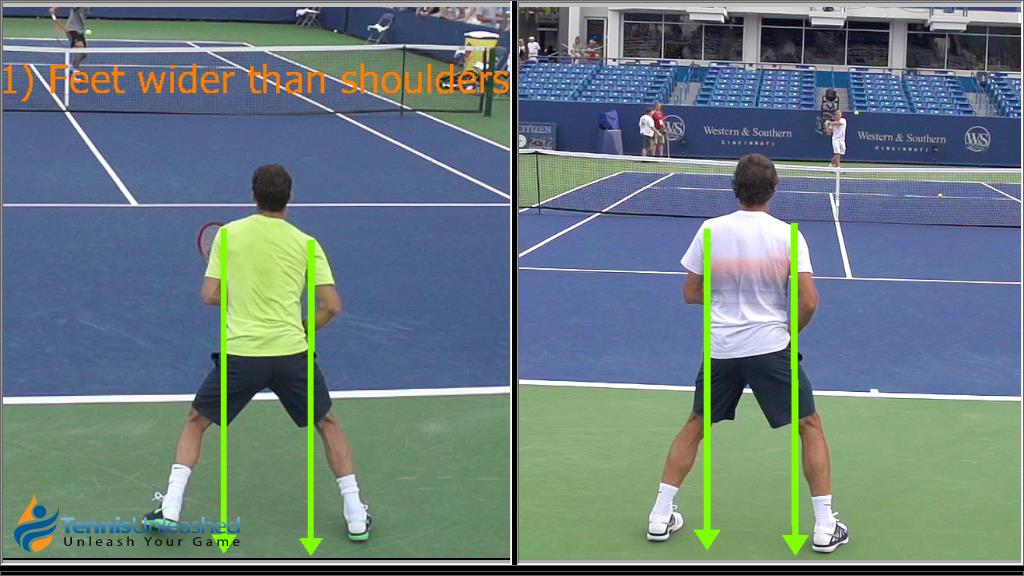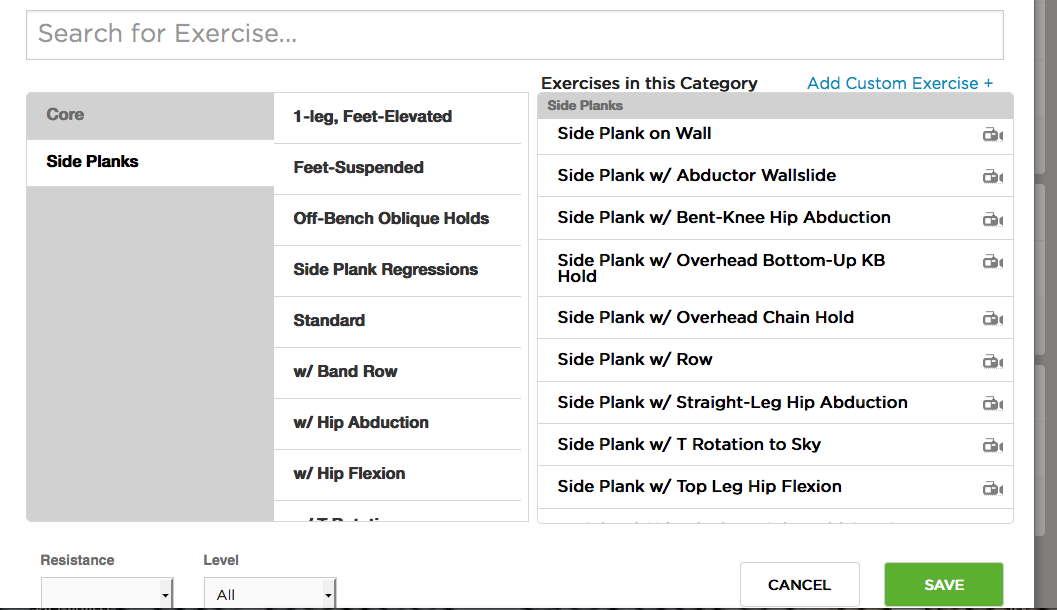Training The Lateral Athlete: Round 2
Last week here on the blogosphere, we looked at a variety of strength exercises the coaches at SAPT have found to be helpful for training the lateral athlete in your life. Today we will discuss getting set up in the correct athlete position and how to perform and progress common drills to help athletes run, decelerate, and explode in a different direction.
The Athletic Position
No matter the sport that you play the solid athletic base position is a fundamental tool that can enhance reaction time, strength, power, and your ability to be productive in competition. All athletes will not look the exact same in their position because of their anthropometric makeup but with the help of a qualified coach anyone will be able to find their “sweet spot.” Listed below are a few of the basics for this position:
- Feet are slightly wider than shoulder width
- Weight is distributed on the balls of your feet
- Back is long and straight with your chest out
- Shoulders back
- Comfortable bends in the elbows, knees, and ankles
After an athlete finds his or her sweet spot in the athletic base position, now it’s time to build upon this and learn to move from this position.
The Push to Base exercise shown here is the signature drill for the execution of this. It can be progressed and regressed in any number of ways but more importantly, it reinforces good weight distribution, balance, and stabilization. The exercise also works wonders in helping athletes create a stronger push off in their first step. One thing to take notice of in the video linked above is that the athlete’s feet return to the athletic base position with each step and do not come together like the athlete in this video.
https://youtu.be/iBmvPEWt5og
Once the athlete has demonstrated proficiency in the above movements and earned the honor of progressing to the next variation, it is time to add some load. The most efficient way to do so is employing a resistance band. This band can either be controlled by a partner or attached to a stationary object like a power rack. This videos show great technique in the partner-resisted variation with an emphasis on the push off.
https://youtu.be/NFe5_p0agO0
The next exercise progression would be to increase the speed of the movement by having the athlete perform a shuffle down to a predetermined distance, typically 5 yards, and back as quickly as possible while stay maintaining the high quality technique that has been emphasized thus far. The next step in the development of this person’s lateral prowess will be to add an opponent to spice things up. This is where mirror drills also known as chaos training comes into effect. The video show below is a great example this mirror drill in practice where one person (white shirt) is performing a movement and the other partner must rapidly react and perform those same movements for a prescribed amount of time.
https://youtu.be/xFtyBEfYC10
Hopefully the information on training lateral moving athletes has opened your eyes and added some weapons to your athletic training arsenal. Check back soon for more great info.
Behind the Scenes at SAPT
Hi there, everyone. Man, it has been a LONG time since I last wrote a post for our blog. In fact, I think it's been several years since I last posted regularly. Some of you reading this will have no idea who I am or what I'm doing intruding on the great content of SAPTstrength.com. Others of you will be wondering where-in-the-hell I've been hiding. Either of those are great concerns and I'm here to (re)introduce myself and, most importantly, let you all know what's been going on behind the scenes at SAPT for the last couple of years and some of the new initiatives we're embarking upon to ensure our vision is reached.
Buckle-up, this may get bumpy (or long-winded).
First things first: My name is Sarah Walls and I founded SAPT in 2007 and continue to act in the role of president of the company.
Now, for the meat. I'd like to tell you what's been going on behind the scenes at SAPT, starting off with myself: Over the past 5 years I've become a mother (two times over), I officially concluded my career as a college strength coach (2 years ago) to focus solely on my businesses, we added a second SAPT "satellite" location in Tysons (1.5 years ago), and I (this is a soft I) have both developed and started a software company that focuses on improving the work-life balance of those in the fitness industry by providing some killer business-grade solutions.
I had a feeling that it would be tough - maybe impossible - to build software. Something we knew NOTHING about. Really, nothing. Plus, SAPT isn't some mega-corp with cash flowing in hand-over-fist. From the get-go, I knew that our staff would be stretched beyond what is reasonable to expect. I also knew our financial resources would be completely tapped by this project. But, I had confidence in both myself and my staff to have the ability to defy all reason with our capacity for conquering any challenge. We'd been defying logic for years already!
For the sake of cutting-to-the-chase, we did it! Concentric Brain is a reality. A reality that is awesome and that is solving problems for fitness professionals all over the country (soon to be world). Along the way, there were many more barriers than I expected or had ever experienced. We're still going through them, in fact!
But, I was anxious to begin pouring effort back into SAPT to repair the cracks that developed from pushing so hard for over a year. As the development wrapped, I began that process. It began with hiring more full-time coaches (Charlie & Jarrett). And that accelerated focus is continuing with what I will lay out for you below.
My own professional development has become the biggest - and most important - challenge I can tackle. I have a goal of making SAPT (and Concentric Brain) synonymous with the idea of the best experiences in the world. This starts with my staff. Over the past few months I have challenged myself to rise to the occasion of running two companies with 8 full-time employees, plus our amazing part-time staff, and many contractors. On a small scale, SAPT coaches have always been quite the satisfied bunch, professionally speaking. My challenge is to learn how to scale that!
On this "adventure" of self-education I have made some amazing discoveries, had incredible experiences, and - most importantly - I think I'm actually starting to do a decent job in developing both companies. How can I tell? Well, just take a look at what we've got planned and what we have already executed.
- FACILITY: Now we're preparing to take several big steps forward! We're more than doubling our training floor space at our current Fairfax location. We've also secured marked, dedicated parking for SAPT clientele. The new space will be cavernous, to say the least, with plenty of room for amazing training sessions, community events, athlete lounge, practice rentals, classroom sessions, and anything else we can think of to enhance our clients' experiences with us!
- SCHEDULE: We recently expanded to open on Sundays! Wow, we've been getting requests for Sundays for years. And, the first couple weeks has not disappointed! Sundays are a pilot for us right now, so please, gobble them up so we can make the easy decision to keep offering them as we move into the summer months.
- CONTESTS: To kick off our celebration of defining what we're best in the world at - client experience - we'd like to announce our first two competitions!
- COACH UPDATES: Our coaches are simply amazing. Check out the bio page to get more info.
- COMMUNITY: We've got an entire year of events planned to enhance the experience the local community has with SAPT and to enhance the experience our clients have. Please check out our new Events page for more information. Our next event will be Kettlebells, One Piece of Equipment: Unlimited Conditioning Potential.
- INNOVATION: As we continue to find new innovative and fun ways to serve others and show the community why "SAPT Cares the Most" you can expect to see an increasing number of opportunities to engage with us. If you have ideas on how to make this happen or how we can serve you better, please let me know directly!
Finally, we have been working very hard on taking our internal culture to the next level. Here are a couple tidbits as it relates to our clients and how we conduct business:
Our Promise to You is that every decision we make will directly be measured against client experience. We believe we can provide a world-class client experience and are doing everything to make sure that alignment occurs.
SAPT's Core Values (the nexus of which makes us so darn special):
- We care the most: no rock is left unturned to ensure every last detail is addressed.
- Innovation: one of our main drivers is the focus on continuous innovation.
- Have fun: Seriously. We ALL do this because it is awesome. Fun is a serious focus.
Alright, well I'm going to leave it a that. Hopefully, this post has helped shed some light on what we've been up to the past couple years, in particular.
If you have any questions or comments for me, let me hear 'em!
#mc_embed_signup{background:#fff; clear:left; font:14px Helvetica,Arial,sans-serif; } /* Add your own MailChimp form style overrides in your site stylesheet or in this style block. We recommend moving this block and the preceding CSS link to the HEAD of your HTML file. */
Subscribe to our Strength Feed
Developing An Athletic Base For Every Sport
At SAPT, we see all kinds of athletes: baseball, softball, football, soccer, volleyball, track and field... the list goes on. We've worked with some of the less-common ones too such as water polo, equestrian, and fencing. (We also have thespians...) Each sport has unique needs and demands and we differentiate those needs as we program for each individual. However, about 80% of an athlete's first couple programs are similar across the board, regardless of sport.
Why? Because most of our new athletes need global strength (they're fairly weak), new movement patterns (they move poorly), and rebalancing (they've developed wacky imbalances from playing their sports).
More often than not, we need to spend the first 1-2 months (or more...) focusing exclusively on these areas before we can start throwing in more sport-specific training methods.
I've said it more times that I can count, but every person MUST be able to:
Squat
Hinge
Hold a plank and do a correct pushup
Row
Walk/Run without looking like a new-born giraffe
These are basic human movements that, when done properly and under load, will increase athleticism of every athlete. They are the foundation of all athletics; these movements make people stronger and more functional than all the bosu ball and agility ladder drills combined.
Individualized programming can take a while. So, to save time, we write program templates that cover the basic movements for every new athlete that walks in our facility.
We have at least 3 waves of program templates for every sport that we come across. Like I mentioned about 80% of it consists of those basic movements and the other 20% are a bit more sport-specific. For example, we'll have shoulder care drills programmed for our baseball players and jump technique work for our volleyball players.
The great thing about templates is I can program all the basic movements under a broad category umbrella for example "goblet squat," and then I can pick and choose the variation that is most appropriate for a particular athlete.
Let's say I have a 15 year old soccer player who has a hard time keeping her knees out, I can choose a goblet squat variation that will tailor to that, for example, goblet squat with bands at knees. I can use that same template for another soccer player who needs more of a challenge so I can choose an ISO hold or slow eccentric variation. I can use templates to save time puzzling out what exercise I want where and I'm able to customize their programs with just a few clicks of the mouse.
To sum it up, all athletes need the ability to perform the foundational movements (squat, hinge, push, row). If they can't do these, and do them well under load, then they have no business getting "fancy."
#mc_embed_signup{background:#fff; clear:left; font:14px Helvetica,Arial,sans-serif; } /* Add your own MailChimp form style overrides in your site stylesheet or in this style block. We recommend moving this block and the preceding CSS link to the HEAD of your HTML file. */
Subscribe to our Strength Feed
SAPT Contests through 4/12/15!
We've got some pretty cool contests planned all year long. To kick things off, here are the first two:


Priming Your Programming
Programming is the poetry of the Strength & Conditioning world, except way more awesome and less awkward to talk about in public. Some programs flow smoothly, creating synergy in movement and some seem to be as random and mundane as a lazy haiku. If you're on this site and reading this, chances are that you have experienced both. And chances are, you've seen the differences in effectiveness as well.
Most people will go with simple antagonistic pairings, ensuring that the exercises don't pull from one another. A simple push-pull template works well for this and is a common go-to for any trainer or coach. Others may go with simple muscle group splits within their pairings, addressing certain fibers appropriately while others rest. Some may even choose to do all their sets of one exercise at a time, not worrying about pairings. These are all tangible ways to design a program, but what if I told you that there was a way to have your pairings improve the effectiveness of one another? To, "prime" some of the movements in the program if you will. (It's oddly satisfying dropping the title of your article in the article).
Yes that's right, by putting certain exercises together, you can actually improve the movement efficiency and strength. I've seen this work with individuals of all training ages. We've had experienced lifters PR and we've had newb trainees show significant improvement in execution of the exercise between sets.
The reason for this is biofeedback. With any exercise of corrective or, "functional" measure, you should see some instantaneous changes in movement when done correctly. Whether it's a sudden increase in range of motion or a new found ability to stabilize a joint. Using a movement to practice muscle synchronization or just prime muscle activity can create a temporary increase in function. Pairing movements that carryover with biofeedback is a sure fire way to drastically improve the effectiveness of the workout. Not only will the trainee be able to lift more weight in the applied movement, it will make the improved function stick that much more. It's a win-win!
So what exercises work well together? Ones that are working upon different aspects of the same pattern. So for example, a deadbug is mainly focusing on the ability of the obliques to stabilize the spine as the hip extends and shoulder flexes. This is addressing activation of the anterior oblique sling, a system of muscles that act together in gait eccentrically during the push-off phase and concentrically during leg swing. If this system is dysfunctional, it's going to severely impact the individual's ability to control the rotation during things like gait or throwing. Due to this, deadbugs are a perfect pairing for a lunge variation, especially for those individuals who like to turn out at the hips. By pairing lunges with deadbugs, we're priming the obliques to stabilize the pelvis/torso and talk to the adductors to stabilize the rotation of gait. This will improve the force transmission of the lunge and create better acceleration and deceleration. AKA Better performance!

Thought must also be put into the threshold strategy at which you're training your client. If you plan on pairing two intensive movements, the chance of good carryover between the two will be minimal, though you can still get a great training affect. Of course, as the individual becomes stronger and more trained, they will be able to perform more advanced variations of each and still have them compliment each other. I personally like to scale it by goal of the more compound movement and training level of the client: higher intensity and max strength work = low threshold pairing. Accessory movements = moderate threshold depending largely upon individual's abilities and training age.
** I feel this should be noted: Any low threshold work you do she be able to be done while maintaining good, diaphragmatic breathing, this will carryover much better as it'll address the local stabilizers much more. You can learn more about threshold strategy here.
So for example, if I have a client squatting heavy for their main movement, I will most likely pair that with a quadruped rocking variation. The rocking is a low threshold version of the squat, so it's addressing the tonic muscles (stabilizers rather than prime movers). This will make the local stabilizers within the spine and hips be more active in the pattern and improve the actual squat. I can also manipulate the rocking variation to address any issues in the squat pattern. So if I want to get more out of the anterior chain of stability, allowing them into a deeper position, I may try an RNT quadruped rockback vs a band. You could get as creative with it as you want for your training purposes. I've seen great success with not only getting people squatting better, faster, but even in improving depth and ease of movement in some of my experienced trainees.
You're going to find that certain movements create more biofeedback for some individuals than others. This is where a good evaluation becomes key to really dissect what needs to be addressed. However, for the most part you are going to see that certain exercises just really mesh well with each other to get people moving optimally. This is why if you look at the templates that I have created in Concentric Brain, you will see that my pairings are matched up as such. All I have to do is match the right intensities and ensure that the variations are appropriate for that individual.
Some other pairings that I really like:
Side Planks and Step Ups: It's pretty common to see some hip hike in step ups, though not at all desirable. A common issue is that people will have poor frontal plane stability and be limited in training this exercise. There is usually some dysfunction in the way the QL, obliques, glute med and adductors talk to each other to stabilize the pelvis in that chain. I have found side plank variations to be great tools for having instant carryover in this pattern. You can choose the variation that puts emphasis on the muscle that you think may be the weak link. They're also very scalable in intensity, making them usable for all levels of trainee.
Bird Dogs and Overhead Presses: Yup, the exercise that has traditionally been a cook-book back care exercise can actually help your overhead press. The bird dog links several movement systems together and when performed correctly should really help with alignment while the shoulder and hip go through full ranges of motion. It's a relatively low threshold movement and as such should get the tonic muscles more active. As I noted in last week's blog, alignment and positioning are the keys to a good overhead press. I've also found that playing with the hand positioning in quadruped rocking variations can be advantageous by creating more scapular stability via the serratus anterior.
SFMA Rolls and Balance Work: Biofeedback actually works on many more levels than just altering range of motion or mechanics. It can actually work with sensory components as well. Many people look at SFMA rolling as a way to disassociate upper and lower limb movements and work on rotational mechanics. They do all of those and because of that, they can have great carryover to almost any movement for those less coordinated. But the other thing they do that is they help to stimulate the vestibular system via the otoliths within the cohclea. Gravity gives us sensory feedback by using the gel-like substance within the otoliths to pull on the hair follicles. Sensory information about the positioning of the hair follicles is sent to the CNS and tells us which way is up. With a lot of people, especially older clientele, this feedback may be muffled due to less sensitivity of the hair follicles. The SFMA rolling patterns make them slowly roll back and forth, causing more movement of the gel-like substance within the cochlea and stimulating the vestibular system. This creates carryover into upright movements by capitalizing on the increased stimulation and its transfer to body awareness. If the rolls are a little too much for someone (they get dizzy easily) then you can even gently rock/shake them while supine to help recalibrate the gel-like substance first. So long as you can put your hands on your client that is.
As you can tell, you can get pretty creative with the combinations. There are several pairings that I use that I didn't even mention in this article for length's sake. All it takes is a bit of thought, creativity and some trial and error. As long as you are taking notes, you'll soon have a toolbox full of pairing variations to get people moving right. This becomes extremely helpful when creating your templates and when put in Concentric Brain, you can easily just pick the variation of the movement appropriate for that person. Once you have your methods and templates down, you will be writing smooth works of art in no time.
Subscribe to our Strength Feed
(Almost) Every Exercise is a Core Exercise!
Yesterday was an awesome day at SAPT. During our 3PM session, we had 6 athletes deadlifting at one time. Considering the deadlift is one of my favorite lifts, the sound of metal hitting the floor repeatedly was music to my ears. After sessions, I was fortunate enough to be able to train my sister, who I love very dearly. She's not the biggest fan of working out, which is pretty funny considering I literally cannot go 4 days without some form of exercise. Ask anyone who really knows me... If I've gone 3 or 4 full days without lifting, I'm going to be pretty grumpy, I won't really be able to give anything else my full attention, and I just won't be Charlie that you've all grown to tolerate.
Anywho, Lexie has been an awesome "client." She's made great progress and she's been doing her best to workout 3 times a week, even though she routinely works 10-12 hours a day. Last night, she came to the gym after a 10 hour shift even though I'm sure that's the last thing that she wanted to do. She's lost 20 pounds so far, and feels mentally and physically stronger than she has in a long time. I'm incredibly proud of her, and very fortunate that she's allowed me to help her over the past few months.
During our session, she was performing a set of stepback lunges and mentioned that she could really feel her core working. It surprised her because a stepback lunge is clearly a leg exercise, right? Not so fast... This may come as a shock, but a stepback lunge is a TOTAL BODY MOVEMENT! Let's break it down and take a look...
- This exercise is working your legs. Notice how I didn't say "This exercise is working your quads." Your body does not work in isolation. Every single muscle in your lower extremities has to contract, whether that be in an isometric, concentric, or eccentric fashion. Those are all fancy kinesiology terms for a muscle that is "resisting movement," "producing force while shortening," and "coming under tension/producing force as the muscle is stretched." Oftentimes, a muscle will contract in an isometric, concentric, and eccentric fashion at different times during the same movement. Lets take the glutes for example: As you stand tall, your glutes are short and, technically, are contracting in an isometric fashion to prevent your hips from flexing and your body from collapsing upon itself. As you take a step backward with your right leg, your left glute begins to undergo a stretch as the muscle lengthens. The glute has to contract ECCENTRICALLY as you near the bottom of the lunge in order to slow you down. If you were to pause at the bottom of the movement, that glute would need to contract ISOMETRICALLY to maintain your hip position. As your pop forward into the starting position, your left glute needs to contract CONCENTRICALLY as it shortens and extends your hips. Now that I've bored you with a bit of biomechanics, let's move on.
- This exercise is also working your arms! You're holding a weight at your chest. If, for some reason, the muscles in your arms and shoulders decided not to take action, the weight would drop out of your hands. Your back is also active, and this segues into our next point very nicely.
- THIS EXERCISE IS ALSO WORKING YOUR CORE/TRUNK/ABS/AXIAL SKELETON/WHATEVER YOUR WANT TO CALL THAT PORTION OF YOUR BODY THAT CONNECTS YOUR UPPER AND LOWER EXTREMITIES! I apologize for the caps, but I need to get my point across. Your core's main function is to aid in force transmission. During a stepback lunge, you're holding a heavy weight in your hands and your goal is to move it from point A to point B. For the sake of clarity, Point A is the bottom of the movement, Point B is the starting/ending point. Your legs need to create force and apply said force to the weight in your hands. Your trunk aids in that force transmission, and acts as an avenue for the force to be applied to the weight in order to move it's mass from Point A to Point B. If, for some ungodly reason, your core decided to completely shut off you would crumple into a heaping mass on the floor. We often see beginners who don't have adequate core strength stumble during these unilateral split-position movements. We watch their upper bodies teeter from side to side, desperately trying to find the stability that they need in order to stay upright.
The bottom line is, ask any normal gym-goer and they'll tell you a stepback lunge is a leg movement. This way of thinking is so misguided. It assumes that the body works in complete isolation. Now this isn't the fault of the individual, rather, it's the fault of society as a whole. Walk into any commercial gym and you'll see machine after machine after machine, each highlighting the 2 or 3 muscles that the exercise is working. It's incredibly frustrating for a strength coach such as myself. Flashback to college.... During my Methods of Human Nutritional Assessment class that I took at Virginia Tech (Go Hokies!), we had one module that was dedicated to introducing us to weight training. We hopped on the leg press, the leg extension machine, the lat pulldown station, and more. I couldn't believe they weren't teaching us how to squat, how to hinge at the hips while maintaining a neutral spine, how to press a load overhead maintaining proper anatomical positioning. I can honestly say that I learned more about my profession by reading blogs and textbooks, watching Youtube videos, and taking part in internships (VT S&C and SAPT) than in class. That is not to say that what I learned in school did not help. Kinesiology and Exercise Physiology were vital in understanding the basics and principles of exercise science. If you want to be a trainer, go to college. Yes, you can take an online certification course and skip that step, but you're missing out on the foundation. That foundation is what will give you the critical thinking skills to scrutinize training philosophies and decide whether their underlying principles are sound.
Now, after that little rant, let's get back to the title of this article. Almost every exercise that you perform at the gym (at least at SAPT because we're friggin' awesome) is targeting your core in some way, shape, or form. Occasionally, we'll get the client who asks to perform more core exercises. It makes me chuckle inside, because if only they knew... That deadlift you just performed? Your last set of squats? The 30-40 pushups that you've knocked out over the course of a session? Yup, you guessed it. All working your core. Anytime an exercises demands that you maintain a neutral spine, your core musculature is working overtime to prevent your hips from sagging and maintain that rigid trunk that allows for efficient force transmission. I really hope this article has helped you look at exercises in a different light. I hope that it reaches the people who actually need to read it. Over the past year or so, I've had a few of my friends ask me to help them with their exercise routine. I always ask them what kind of routine they've been on prior to seeking me out, and 99% of the time it goes something like this... "Mon is chest and tris, Tues is back and bis, Thurs is shoulders and core, and Fri is legs." If you've gotten this far, I don't need to explain why this makes me want to run my head into a brick wall. These are the people that this article needs to reach. If you know someone like this, share it with them. Maybe they'll hop on a 3x/week full-body program, or a 4x/week push/pull routine as a result. They'll be thanking you once they realize how long they've been spinning their wheels.
As always, please reach out if you could use my help. Our main mission here at SAPT is to help as many people as humanly possible. We're in the service industry, so please, let us serve you. Also, in the next few weeks we're going to be launching a huge sale on training packages as well as expanding our facility to double its current size. The sale is going to last 2 WEEKS ONLY, so take advantage of it before it's too late. If you aren't in the area, we also provide distance coaching and fitness consultations. Just ask. What's the worst that could happen?
EDIT:I had a reader (Scott Van Zandt) make a very astute observation while reading this article. He mentioned that we need to make a distinction between what an exercise TARGETS, and what an exercise WORKS. For example, the deadlift targets the lifter's posterior chain, but it works almost every single muscle in the human body. This is absolutely correct. Revisiting the article, the stepback lunge does indeed target the lower extremities, but it also works almost every muscle in the body, just like the deadlift. I love that Scott made this observation, as it doesn't take away from anything said in this article, but it provides me with a fantastic idea for a follow-up post. Next week, we'll talk about weak points that hold experienced lifters back in a given lift, and what the most effective method for bringing up this weak link is. Bravo Scott. Thanks again for input.
















